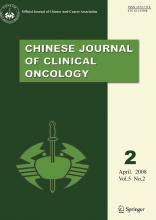Abstract
OBJECTIVE The chemokine receptor (CXCR4) CXC chemokine receptor 4) plays an important role in cancer metastasis. We therefore studied differential expression of the CXCR4, as well as that of the biomarker HER2, so as to evaluate whether these biomarkers can be used to predict axillary lymph node metastasis in breast cancer patients.
METHODS Immunohistochemistry was used to evaluate the CXCR4 and HER2 expressions and to examine the paraffin sections of the breast cancers at various stages. Positive lymph node expression was found in 80 of the cases, and in 7 there was negative expression.
RESULTS Compared to the cases with negative lymph nodes, there was a high expression of CXCR4 (26.3% vs. 14.3%, P = 0.013), and an over-expression of HER2 (28.8% vs. 14.3%, P = 0.011). Moreover, there was a direct correlation between the CXCR4 and HER2 expressions and the tumor staging (P = 0.000) and lymph node metastasis (P = 0.032). When the two biomarkers, i.e. CXCR4 and HER2, were concurrently labeled, a high expression of one of the biomarkers could be seen in the cases with positive lymph nodes (51.3% vs. 28.6%, P < 0.003).
CONCLUSION The chemokine receptor, CXCR4, is a new-type biomarker in predicting axillary lymph-node metastasis in breast cancers. Compared with the other markers, such as HER2 etc., assessment of CXCR4 can improve the prediction of the presence and extent of lymph node involvement.
keywords
Introduction
Several unverified biomarkers have been used to evaluate the potential of lymph node metastasis[1], in order to avoid clearing of axillary nodes in cases with early stage (Stage-T1) breast cancer. For example, HER2 is a well-known biomarker related to breast cancer metastasis. However, the value of HER2 over-expression is questionable in predicting the presence of lymph node metastasis[2,3]. Recent studies have shown that in breast cancers, the interaction between a chemokine receptor and its ligand in host organs may play a role in the metastasis of malignant tumors[4,5]. There is a high expression of the chemokine receptor CXC chemokine receptor 4 (CXCR4) in the primary focus with metastatic breast cancer, and a high expression of the CXCR4’s ligand, SDF-lα in liver, bone marrow, lung and lymph nodes. In our study, therefore, the expression of CXCR4 and HER2 in breast cancer patients with positive and negative lymph nodes was investigated, in order to evaluate the potential of these markers in predicting axillary node metastatic involvement.
Materials and Methods
General data
All specimens from the 87 breast cancer patients in our group were collected from the cases in our hospitals, i.e. the Bengbu Central Hospital, or the Affiliated Hospital of Bengbu Medical College, during a period from January 2001 to December 2006. WHO pathological typing was used to classify the cases, which included the following carcinomas: infitrating ductal, medullary, intraductal and infiltrating lobular. Based on the UICC TNM staging, Stage-I to II diseases were found in 52 cases, and Stage-III to IV in 35. There were 80 cases which were lymph node positive, and 7 lymph node negative. Lymph node clearance was conducted in all the patients, and evaluation performed by routine H&E staining. All patients were female, with a mean age of 43.3 years. Data from all cases were retrospective.
Reagents and Methods
The SABC method from the Wuhan Boster Bioengineering Co. was used to assess the immunohistochemical stains expressed by the CXCR4 protein. The first antibody was mouse-antihuman CXCR4 (R&D Co.). The SP method from the Fuzhou Mai Xin Biotechnology Development Co. Ltd. was used to assess the HER2 protein, employing MBI MAB-0918 mouse anti-HER2 as the first antibody.
Methods
Histological sections with established positive results were used as positive controls in the immunohistochemical (ICH) staining, and PBS was used to replace the first antibody in negative controls. The positive criterion of HER2 was based on formation of a brownish-yellow color on the cellular membrane (CM). A score of 0+ was defined as no membrane staining or barely perceptible membrane staining in less than 10% of cells, a score of 1+ was defined as barely perceptible membrane staining in more than 10% of the cells, a score of 2+ was defined as weak-to-moderate complete membrane staining present in more than 10% of the tumor cells, and a score of 3+ was defined as strong complete membrane staining in more than 10% of the tumor cells. The HER2 could be deemed as positive if the CM of more than 10% of the tumor cells was stained.
CXCR4 was considered positive cells, if the CM or cytoplasm presented a brownish-yellow color. The ICH staining of the sections was classified as low, moderate or strong staining based on the background. Appraisement of the positive cell percentage was based on a ratio of the positive tumor cell count to the total tumor cell count. At the same time, nuclear staining of the specimen was observed.
Statistical analysis
SPSS10.1 software was used for statistical analysis. Absolute variables were determined using the χ2 test with the value of P < 0.05 set as a statistical significance. Multifactorial linear regression analysis was used for health risk-factor appraisement.
Results
CXCR4 expression in breast cancers
APEARMAN correlation analysis showed that there was a positive correlation between CXCR4 expression and the TNM breast cancer staging as well as with lymph node metastasis. The positive rate was 24.6% (14/57) in cases with less than 3 lymph node metastases, and 53.3% (16/30) in cases with more than 3 lymph node metastases, showing a statistical significance between the two groups (P = 0.032). The positive rates of the TNM Stage-I to II and the Stage-III to IV cancers were respectively 10.5% and 77.1% (P = 0.000). There was no significant correlation with patient’s age (P = 0.453) and their menses status (P = 0.785). In addition, there was a positive correlation between CXCR4 expression and the HER2 (P = 0.015) biomarker (Table 1).
Relationship between CXCR4 expression and clinicopathologic parameters of the breast cancers.
Correlation factors relating lymph node metastasis
Compared to cancer tissues associated with positive lymph nodes, high cytoplasmic staining of the CXCR4 (26.3% vs. 14.3%, P = 0.013) and HER2 overexpression (28.8% vs. 14.3%, P = 0.011) were present if there were positive lymph nodes. A high expression of CXCR4 was found in 32.2% of the cancers with positive lymph nodes, and only 12.5% of the cancers with negative lymph nodes. When the two biomarkers (cytoplasmic CXCR4 and HER2) were concurrently utilized, either CXCR4 or HER2 expression was apparent in 51.3% of the cancer cases with metastases. Compared to the assessment of only one biomarker, detection sensitivity was enhanced (cytoplasmic CXCR4 positive 26.3%, HER2 positive 28.8%) by the use of the two biomarkers. Therefore, the detection rate of lymph node metastasis was enhanced by concurrent employment of the two biomarkers (Table 2 and Fig.1).
Analysis of the correlation factors with lymph node metastases.
A, Negative expression of CXCR4; B, Low expression of CXCR4; C, Over-expression of CXCR4, and D, Over-expression of HER2, among which there was in C and D the same specimen from the case with more than three lymph node metastases.
Discussion
Lymph node metastases are at present, still the major reference index for the judgment of breast cancer prognosis and making a treatment plan. However, there is no detection index completely suitable for routine clinical application. Currently the mechanism of tumor cellular infiltration and production of lymph nodes remains unclear. Previous studies[6] have shown that there is an expression of the chemokine receptor CXCR4 in several immune cells, and that the CXCR4 and its CXCL12 ligand will play a major role in tumor-cell homing to lymph nodes or organs. It has been found in recent studies[7-9] that CXCR4 also is expressed in the malignant tumor cells, and it may be involved in lymphatic metastasis and breast cancer progression.
In our study, the biological significance of CXCR4 expression in breast cancers, with or without lymph node metastasis, was analyzed to investigate whether CXCR4 expression could be used in predicting the percentage and scope of axillary lymph node metastasis. Our findings indicated that positive CXCR4 cytoplasmic staining and HER2 over-expression are significant biomarkers to suggest the presence of lymph node metastasis. Moreover, the co-expression of CXCR4 and HER2 is a more sensitive index of lymph node infiltration than a single biomarker.
In 2003 a report[10] confirmed that the SDF-1α/CXCR4 signaling axis can play a definite role in lymph node metastasis of cancers. Studies conducted by Blades et al.[11] demonstrated that the induction of SDF-1α/CXCR4 may allow the invasion of lymphoid tissue by peripheral leukocytes via the blood circulation. Tamamura et al.[12] found that the antagonist T140 of CXCR4 can inhibit the in vitro transmigration of the breast cancer MDA-MB-231 cells, and in an animal model of human breast cancer-bearing mice, it can reduce the occurrence of metastasis to the lung. To summarize the above, an increase of the CXCR4 expression in a primary tumor may indicate the state of lymph node metastasis and that high CXCR4 expression indicates more extensive lymph node metastasis.
The HER2 cancer gene is a member of the growth factor receptor-I family. HER2 enhances CXCR4 ex-pression, i.e., on one hand, HER2 accepts the signals of an extracellular domain, and stimulates cell growth through the tyrosine kinase pathway; on the other, HER2 enhances breast cancer cell metastasis by stimulating CXCR4 expression. It was found in our studies that there was a correlation between over-expression of HER-2 and an unfavorable prognosis. It has been demonstrated[13] that remission and survival rates of breast cancer patients with an over-expression of the HER-2 were both unfavorable. Our results also showed that HER2 over-expression correlated with axillary lymph node metastasis. Currently biotherapy targeting at the HER2/neugene (i.e. c-erbB2 gene) site is a recent worldwide mode of treatment. Herceptin, a new drug developed in the US has been approved by the FDA. This is the first clinically applied human anti-HER2/neu monoclonal antibody[14].
Although we have reported the correlation and high specificity of the CXCR4 and HER2 biomarkers in lymph node infiltration, as an independent factor, over-expression of the HER2/neu gene was found in only 20%~30% of the breast cancer patients. The combined assessment of CXCR4 and HER2 expression may predict half of the lymph node metastasis, thus considerably improving the sensitivity of detections.
In short, our data have shown that the chemokine receptor CXCR4 is a new-type marker for breast cancer lymph node metastasis. It can be helpful to predict the possibility of lymph node metastasis, and with HER2 relate to the lymph node state to direct the mode of surgery, treatment plan and develop a prognosis. Specific antagonists are expected to be employed to target malignant tumors. Emergence of the newHER2/neu monoclonal antibody treatment brings hope for breast cancer patients.
Footnotes
This work was supported by grants from the Anhui provincial Natural Science Foundation (No. 070413119), the Anhui provincial program for Applied Technology of Clinical Medicine (No. 06B105) and the Bengbu Scientific Planning Project (No. 200617).
- Received September 9, 2007.
- Accepted January 17, 2008.
- Copyright © 2008 by Chinese Anti–Cancer Association












